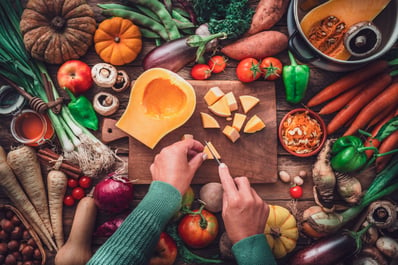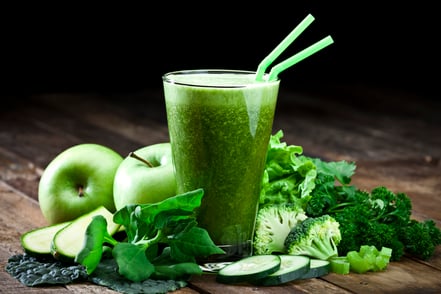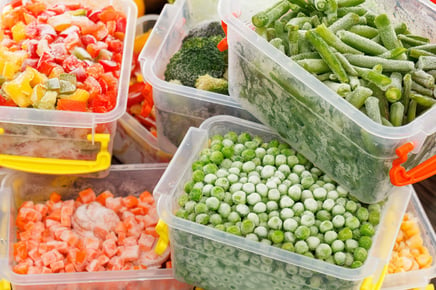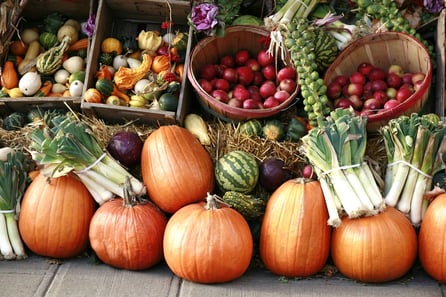 Intuitive eating is the practice of eating in response to your body’s internal hunger and fullness cues, rather than external cues, such as environmental or social triggers that prompt eating behaviors, regardless of true hunger or fullness levels. In today’s society, it is especially difficult to eat intuitively as we are near constantly being bombarded with messaging that tells us what we should or shouldn’t eat and that labels foods as “good” or “bad.” Overtime, as the mind and body become used to ignoring hunger signals, the cues begin to fade and are more and more difficult to notice or may only be noticed when the body is in an extreme, ravenous state, which is likely to lead to overeating, which is then followed by feelings of guilt and desire to restrict based on external cues and continued ignoring of internal hunger cues. For many, the body must be reconditioned, starting with reconnecting with your biological hunger cues. Here’s how to start:
Intuitive eating is the practice of eating in response to your body’s internal hunger and fullness cues, rather than external cues, such as environmental or social triggers that prompt eating behaviors, regardless of true hunger or fullness levels. In today’s society, it is especially difficult to eat intuitively as we are near constantly being bombarded with messaging that tells us what we should or shouldn’t eat and that labels foods as “good” or “bad.” Overtime, as the mind and body become used to ignoring hunger signals, the cues begin to fade and are more and more difficult to notice or may only be noticed when the body is in an extreme, ravenous state, which is likely to lead to overeating, which is then followed by feelings of guilt and desire to restrict based on external cues and continued ignoring of internal hunger cues. For many, the body must be reconditioned, starting with reconnecting with your biological hunger cues. Here’s how to start:
1. Start paying attention to how your body signifies hunger.
The most common and well-known symptoms of hunger include stomach grumbling or growing/gurgling noises; however, hunger may also present as feelings of fatigue or irritability, lightheadedness, and occasionally, with prolonged hunger, even nausea.
2. Before each meal/snack - rank your hunger/fullness on a scale of 0-10. Consider why you are eating - is it for internal reasons or external?
0: Primal hunger - intense and very urgent, may be painful
1: Anxious to eat, ravenous and irritable
2: Very hungry, looking forward to a hearty meal or snack
3: Ready to eat, but no urgency; “polite” hunger
4: Subtle hunger, slightly empty feeling in the stomach
5: Neutral - neither hungry nor full
6: Emerging fullness
7: Comfortably full - satisfied and content
8: Full - not pleasant, but not unpleasant
9: Very full/too full (as if you need to unbutton pants or remove belt)
10: Uncomfortably, even painfully full. May feel nauseated.
3. Aim to eat a balanced meal or snack (protein + fiber + healthy fat) when hunger level is below a 5.
If you are feeling hungry, consider what foods will be most nourishing and what you may have lacked in previous meals (typically fiber or protein).
If you still have the desire to eat despite being >6 on the hunger scale, you may be mistaking true hunger for a different type of hunger, such as emotional hunger, or desire to eat to cope with uncomfortable feelings, or taste hunger, or a desire to eat based on taste or because a food sounds good. It’s OK to eat for taste or comfort on occasion, but for many, due to the years of prolonged suppression of natural hunger cues, practicing portion control in these settings becomes difficult, and overeating often occurs. In these instances, consider other ways to cope with boredom or stimulate the senses that don’t involve food, such as taking a walk, reading a book, calling a friend, lighting a candle, or putting on lotion.
If you’re still struggling with the concept of intuitive eating, how to implement it, or how to identify true, physiological hunger vs emotional or taste hunger, consider reaching out to a dietician for support!

 Did you know it is estimated that food loss and food waste account for more than 8 percent of total human-made greenhouse gas emissions, a leading driver of climate change? According to the US Department of Agriculture (USDA), it is estimated that 30–40 percent of the food supply (130 billion pounds of food) goes to waste each year. Additionally, the United Nations has
Did you know it is estimated that food loss and food waste account for more than 8 percent of total human-made greenhouse gas emissions, a leading driver of climate change? According to the US Department of Agriculture (USDA), it is estimated that 30–40 percent of the food supply (130 billion pounds of food) goes to waste each year. Additionally, the United Nations has 
 We’ve all been here before: When it seems the long, gray winter will never end and you make one more pot of hearty vegetable soup or another casserole; or when the lackluster tomatoes and almost pinkish-white strawberries just aren’t cutting it. It’s time to get creative!
We’ve all been here before: When it seems the long, gray winter will never end and you make one more pot of hearty vegetable soup or another casserole; or when the lackluster tomatoes and almost pinkish-white strawberries just aren’t cutting it. It’s time to get creative!
 ’Tis the season for swapping Christmas cookies, candy bowls, Hanukah dinners, holiday parties, and New Year’s Eve libations. We’ll take this month to refocus on a 10 simple ways to keep your body properly nourished and healthy this holiday season while keeping in mind that it is okay and certainly encouraged to partake in the holiday season festivities. New Year’s Resolutions are a great time to start new habits, but why not get a head start?
’Tis the season for swapping Christmas cookies, candy bowls, Hanukah dinners, holiday parties, and New Year’s Eve libations. We’ll take this month to refocus on a 10 simple ways to keep your body properly nourished and healthy this holiday season while keeping in mind that it is okay and certainly encouraged to partake in the holiday season festivities. New Year’s Resolutions are a great time to start new habits, but why not get a head start? Since you were young you probably have been told to eat your fruits and vegetables. Fruits and vegetables are the nutritional powerhouses of your diet. They offer essential vitamins, minerals, fiber, and phytochemicals that not only keep your body healthy, but also protect against cancer, heart disease, stroke, and other health conditions. During the winter months, fresh fruits and vegetables are more limited and generally more expensive. As a result, many of us turn to canned or frozen options. So are canned and frozen options just as healthy as the fresh produce we consume?
Since you were young you probably have been told to eat your fruits and vegetables. Fruits and vegetables are the nutritional powerhouses of your diet. They offer essential vitamins, minerals, fiber, and phytochemicals that not only keep your body healthy, but also protect against cancer, heart disease, stroke, and other health conditions. During the winter months, fresh fruits and vegetables are more limited and generally more expensive. As a result, many of us turn to canned or frozen options. So are canned and frozen options just as healthy as the fresh produce we consume? The air is crisp, football season is in full swing, and the plentiful bounty of summer’s gardens is all gone. Instead of reverting back to the frozen fruit and veggie staples that are typical of fall and winter, experiment with some of the tasty foods that give fall the name the harvest season!
The air is crisp, football season is in full swing, and the plentiful bounty of summer’s gardens is all gone. Instead of reverting back to the frozen fruit and veggie staples that are typical of fall and winter, experiment with some of the tasty foods that give fall the name the harvest season!